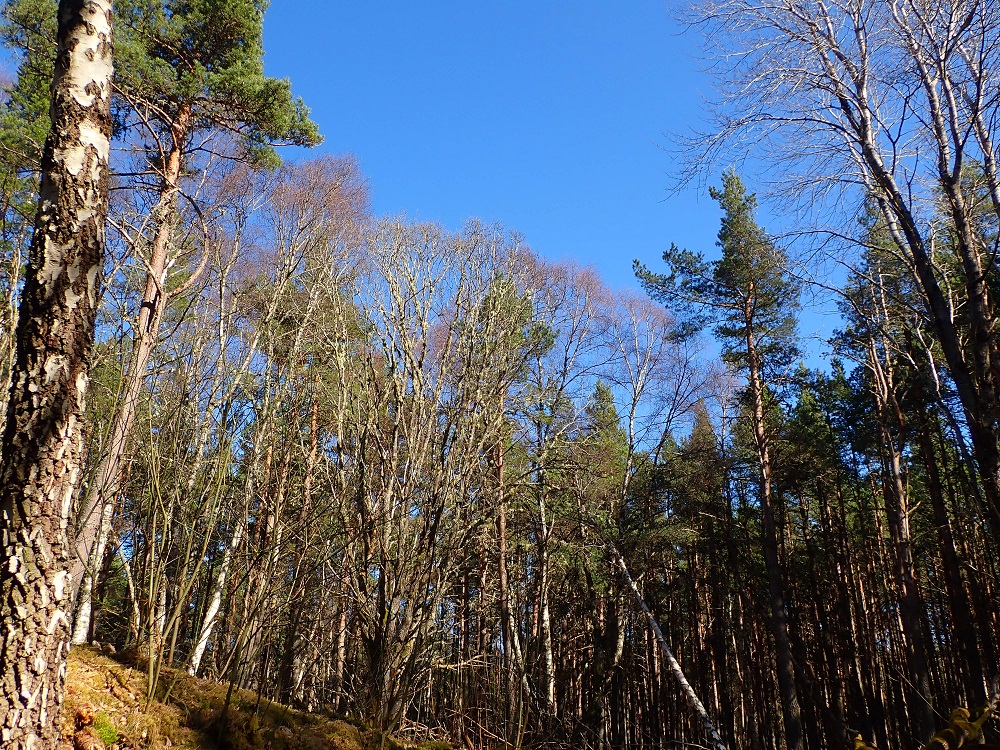
The village of Nethy Bridge prides itself as being the Forest Village, being almost fully surrounded by woodland and forest, much of which is classified as ancient woodland. Yet developer Castle Glen Properties of Aberdeen has submitted a planning application for planning permission in principle to the Cairngorms National Park Authority for the construction of 20 houses in this ancient woodland.
The planning application (CNPA ref: 2020/0064/PPP) can be viewed at here. The closing date for objections has been extended to midnight on 20 April. To date there have been objections from 33 people or organisations.
This article aims to summarise the main reasons why this application must be rejected by the CNPA Planning Committee. Credits are due to the information provided by the many objectors, and I apologise if I have, for the sake of brevity, omitted any issues that any of the objectors considered to be important.
Site Plans (extracted from the planning application)
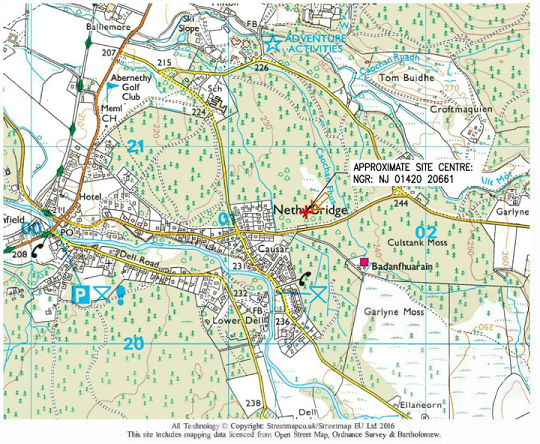
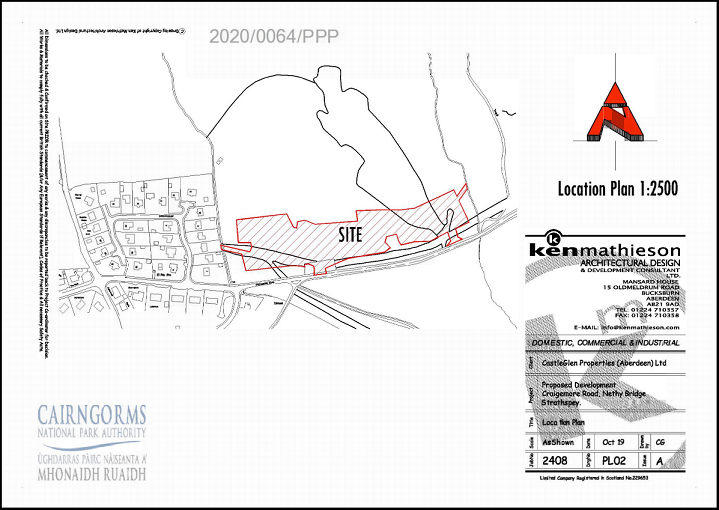
A critical test for the Cairngorms National Park
This is clearly a highly controversial planning application which has engendered considerable concerns amongst local residents. It is a test of whether the CNPA believes in the true aims of this National Park, or whether development at the cost of our irreplaceable natural heritage is permitted to supersede all other considerations within a National Park.
There have been some underhand actions in the processing of this application already. Conforming to the usual process, the application was first submitted to Highland Council, before being called in by CNPA Planning. However it would appear that Highland Council arbitrarily decided to redact parts of the supporting documents (not just personal details), and it was only when one of the objectors, Stewart Taylor, complained that these redactions were in the main removed and more public consultation time provided as a result. Unfortunately some strange and possibly contentious redactions on the applicant’s supporting documents, including even the Design Statement, remain.

Reasons for retention of these redactions needs to be explained by CNPA.
The other test for CNPA Planning is how this application can be adequately and publicly considered by the Planning Committee given the major restrictions of Covid-19. Given the complex and controversial content of the application, will a competent and publicly witnessed site visit by the Committee be possible prior to consideration of the application? Several objectors wish to address the Planning Committee, what facilities will CNPA make available for this to happen? Lastly, the deliberations of the Planning Committee are supposed to be open to public scrutiny. Can this happen during the current Covid-19 restrictions, especially when CNPA several years ago stopped making a recording of Planning Committee business? Although the closing date for public comments is 20 April, many of the statutory consultees (including SNH) have yet to respond. The lack of these important responses prevents public comment on what these consultees have said.
What follows is a summary of the many and complex objections to this proposed housing development.
Planning Context
By misadventure, the site was included in the current Local Development Plan (LDP) adopted on 26 March 2015.
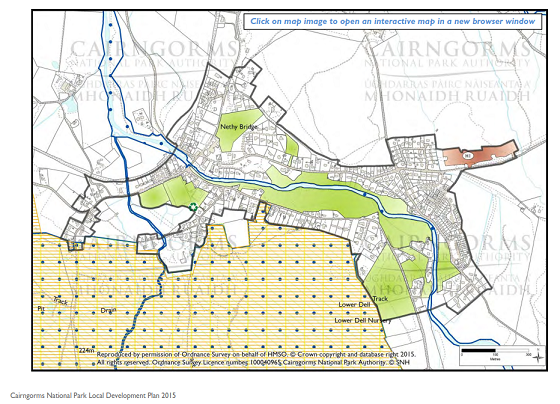
Roy Turnbull in his detailed objections makes clear that the Scottish Government Reporter made a significant error that apparently resulted in this site’s wrongful inclusion in the 2015 LDP. The Cairngorms Campaign, along with 12 other environmental organisations, presented further ecological evidence to Scottish Ministers in 2014 that should have resulted in this site being deleted from the adopted LDP, but their letter went unheeded.
Of planning significance is the fact that the 2015 LDP is now over 5 years old and, according to Scottish Government policy, is now of questionable value. The new proposed 2020 LDP is currently with Scottish Ministers and was due for adoption this month. It is a significant planning consideration that this site has deliberately been removed from the proposed 2020 LDP, mainly for the reasons of it being ancient woodland with a significant contribution to biodiversity and protected species.
The site’s exclusion from the proposed 2020 LDP should be a very significant planning consideration, apart from the issue of CNPA appearing to be inconsistent in going against its brand new proposed LDP if it were to approve this application.
Contravention of planning policies
This application goes against numerous planning aims and policies.
Starting with the aims of the Cairngorms National Park:
Aim 1: To conserve and enhance the natural and cultural heritage of the area. Clearly a new development in an area listed in the Ancient Woodland Inventory as “Ancient of Semi-Natural Origin” will not conserve or enhance this woodland or the woodland that surrounds it.
Aim 2: To promote sustainable use of the natural resources of the area. Clearly building houses in an ancient woodland of semi-natural origin is not a sustainable use of this precious natural resource.
Aim 3: To promote understanding and enjoyment (including enjoyment in the form of recreation) of the special qualities of the area by the public. Building houses in this woodland will diminish public understanding and enjoyment of this special area of woodland. An example of supporting this aim was the recent BBC Springwatch series. Our National Park needs to build on this opportunity and reputation and not destroy it by approving developments within our natural woodland.
Aim 4: To promote the sustainable economic and social development of the area’s communities. Too often our CNPA Planning Authority interprets building new housing (especially with an affordable element) as being economically sustainable. Given the declared Climate Emergency, loss of ancient woodland is no longer sustainable development.
Then we have Scottish Planning Policy (SPP):

This application has also been shown by several objectors to not comply with both the 2015 LDP and the 2020 LDP policy 4 – Natural Heritage.
The 2020 LDP states:
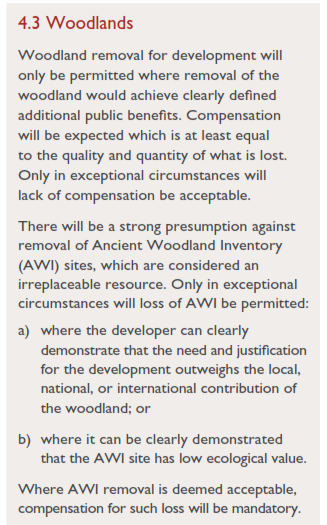
In the supporting documents the developer has not demonstrated any exceptional circumstances for loss of this ancient woodland.
Roy Turnbull also demonstrates that this application does not even meet the requirements set out in the 2015 LDP for General Design Guidance and Natural Heritage specifically laid out for Nethy Bridge:
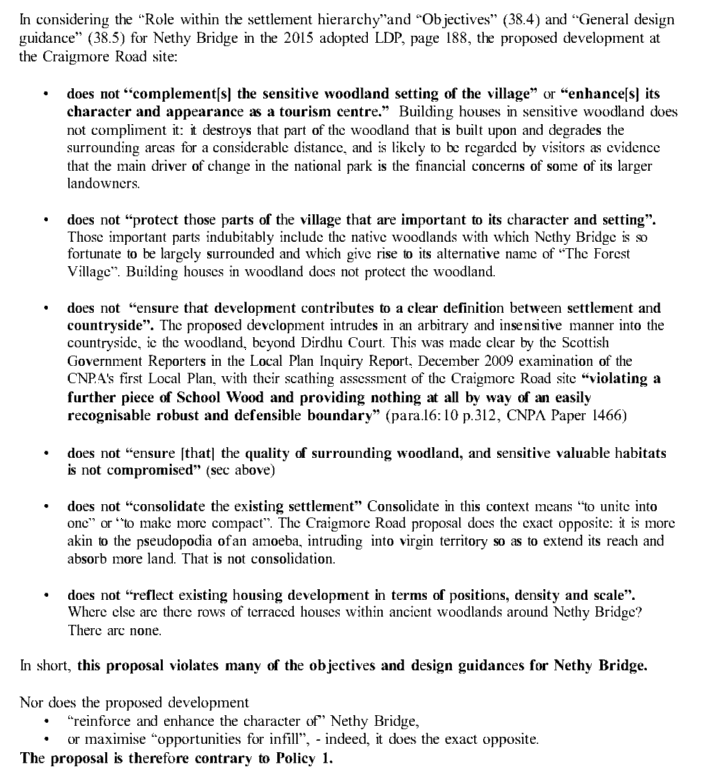
Environmental and ecological issues
The main ecological and environmental evidence provided by the developer to support the application is a report by Astell Associates entitled “Preliminary Ecological Appraisal & Extended Phase 1 Habitat Survey”. For a site of such rich ecology and natural heritage this is a very rudimentary document, especially when planning guidance requires exceptional circumstances to be demonstrated for development within ancient woodland. The survey is primarily based on some basic ‘desk study’ work and believe it or not two days of site walkover in the middle of winter – 31 December 2019 and 1 January 2020. Some objectors have asked whether conducting this survey in the middle of winter was a deliberate act to minimise ecological findings? Whether that is true or not, any competent planning authority should have made clear to the applicant that this survey was completely inadequate to support such an application for development in an ancient woodland.
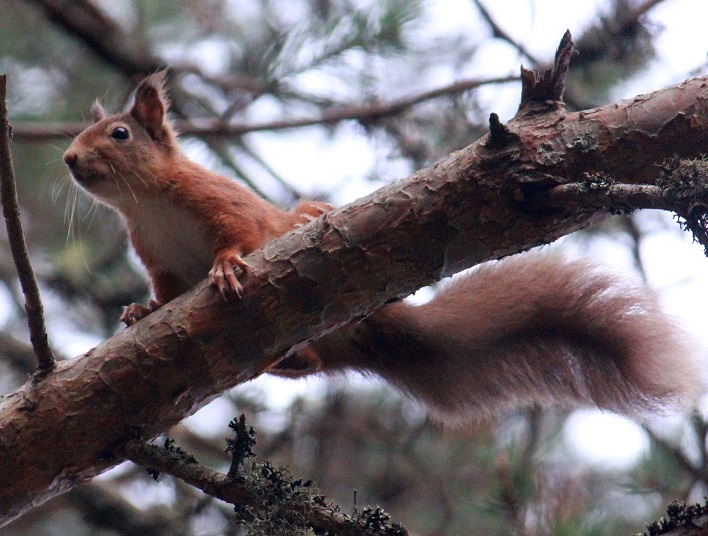
A summary of the environmental and ecological objections include:
Capercaillie (Annex 1 and Scottish Biodiversity List): Even Astell Associates report stresses that this site “could be important as a dispersal route between (these) breeding populations”. Many of the objections point out numerous inaccuracies in the report. A key factor in the survival of capercaillie is the protection of means by which breeding populations can disperse and intermix. A further constriction of means of dispersal increases the risk that current populations will not survive. CNPA has received a considerable sum of public money for the Cairngorms Capercaillie Project. Permitting this development is completely contrary to the aims of this project.
Otter (European Protected Species and Scottish Biodiversity List) : Many objectors present evidence of significant otter activity in the burn on the site and the surrounding land, but this is belittled in the survey report. Of particular note is the comment by the International Otter Survival Fund in their objection in which they say, “I am afraid there are a number of flaws [in the Astell Associates survey] and I’m not sure they fully understand otter ecology and behaviour”.
Bats (European Protected Species and Scottish Biodiversity List): Badenoch and Strathspey Conservation Group in their comprehensive objection on ecology and protected species demonstrate that there has only been a basic survey of bat roost potential (which has missed evidence) and there has been no survey of bat activity, thus the adverse impacts on bats cannot be assessed.
Breeding Bird Survey: none conducted
Red Squirrel (Scottish Biodiversity List): BSCG rightly question much of the accuracy and conclusions in the Astell Associates survey.
Fungi: The site is rich in rotting and decaying wood, a key part of any ancient woodland. BSCG point out that despite this no mycological survey has been conducted to support the application. BSCG state that 31 fungi were found on a single visit to the site including two rare species.
Invertebrates: Again there has been no invertebrate survey to support this application. BSCG and Buglife amongst others point out numerous rare species of spider, bees, moths and beetles all identified as being present on the site.
Reptiles and Amphibians: The BSCG objection summaries the issue with reptiles and amphibians by saying, “The footprint [of the site] and nearby supports common lizard, common toad and frog, of which lizard and toad are on the SBL [Scottish Biodiversity List]. We are very concerned that there has been no survey of reptiles and amphibians and note that no justification has been given as to how the proposal will not adversely affect reptiles and amphibians.”
In summary, going back to Scottish Planning Policy, the Control of Woodland Removal Policy states:
“There will be a strong presumption against removing the following types of woodland: ancient semi-natural woodland; woodlands listed as ‘Plantations on Ancient Woodland Sites’ (PAWS). There will also be a strong presumption against woodland removal where it would lead to fragmentation or disconnection of important forest habitat networks.”
This policy is in place not just to protect trees, but to protect the rich biodiversity that an ancient woodland supports. It is very clear that the applicant has not provided any valid reasons why this protected woodland should be majorly impacted by this housing development.
Compensatory planting
The applicant has proposed compensatory tree planting of an area of meadow which has not been ploughed for many years. In my objection, I stated that I thought this compensatory planting was a joke! How by any stretch of the imagination can the removing a substantial number of mature trees from an ancient woodland and substitution with tree saplings planted in another area be considered compensatory planting? There is also the issue of what ecology in the unploughed field is being destroyed to create a woodland of saplings and the loss of community benefit currently derived from this small open space in the middle of the village.
Other planning considerations
There are numerous other matters raised by objectors, including traffic issues and the appropriateness of the proposed house designs in a woodland context, but I want to just mention one of these. The Design Statement states in p14:
“the properties will be road and south facing to take advantage of solar gain.”
However, elsewhere in the document it is emphasised that the houses will be screened from the road by retained mature trees. What the application’s consultant architect forgot was that these retained mature trees lie south of the proposed houses and thus will shield the houses from solar gain. Additionally, there is a history of residents (even in the Cairngorms National Park) applying for mature trees to be removed which are close to their houses – and this permission being given by the planning authority.
What needs to happen now
- Please consider lodging an objection (here) before midnight on Monday 20 April, if you have not already done so . The objection doesn’t have to be long and detailed. Even commenting on ensuring in these times of restrictions that consideration is given to enabling objectors to address the Committee and ensuring the meeting is broadcast would be helpful
- CNPA Planning Authority should suspend all consideration of this planning application until the Covid-19 restrictions are in the main removed to enable appropriate site visits by the Planning Committee, objectors to address the Committee and proper public scrutiny of the Committee’s discussions.
- CNPA Planning Authority should give full consideration to its proposed 2020 LDP and give it precedence over the old 2015 LDP
- CNPA Planners should strongly recommend rejection of this application.
Please do not allow destruction of any more ancient woodland. No matter what the compensation package is it will take life times to bring it up to ancient woodland quality. The icon species that this woodland supports are so special and destroying more habitat will put them under more pressure. Although from Ayrshire I know the area well.
Totally agree with you, Sally. It would be appreciated if you can find the time to submit an objection to this application on the CNPA website – link provided near the start of the blog. Also if you can encourage others, that would be great. The objection doesn’t have to be detailed and can be short.
Sorry, I meant to add that even your comment on this blog could be used as an objection if submitted to CNPA..